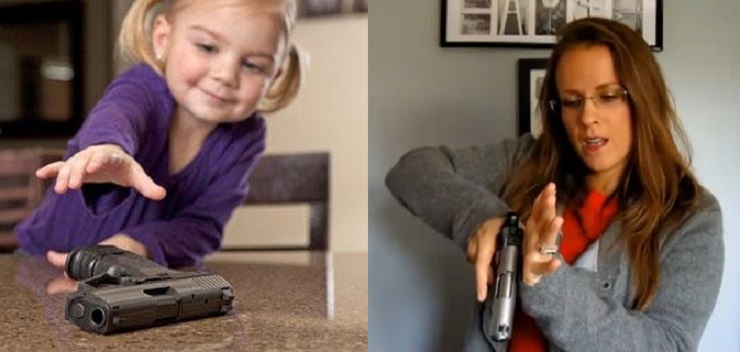
In 2013, a group of Silicon Valley entrepeneurs came together to create the Smart Tech Challenges Foundation - an organization dedicated to incentivizing the development of smart gun technology. In January of 2014, they launched the first Smart Tech for Firearms Challenge to offer grants to inventors, startups and companies that share their passion for gun safety, technological innovation, and market-driven solutions.
Since that time, a number of tragedies have occured which highlight the importance of this competition and the need for safety features that ensure that only a gun's registered owner can use it. Many of these incidents involved the accidental shooting of young children, resulting in fatalities and critical injuries which could have been prevented.
Earlier this month, three young children were accidentaly shot in the area of Houston in just four days, two of which resulted in fatalities. In the first incident, an unnamed three-year-old boy shot himself in the head while in his own home. This was followed by the death of a four-year-old boy who shot himself while at the home of a family friend. The third and latest involved a young boy being shot by his five year old brother.

Shooting accidents involving unattended, unsecured, loaded weapons are more common than expected. Credit: nyagv.org
The region was also rocked by tragedy last November when another four-year-old boy died in a shooting incident in a west Houston suburb. The boy in question, Ryan Welch, was shot in the face with a .40-calibre Smith & Wesson pistol that he and his brother found in a closet next to a BB gun and a machete. It was unclear at the time whether or not it was Ryan or his six-year-old brother who pulled the trigger.
Just the other day, in Jefferson, Georgia - a township roughly 100 km northeast of Atlanta - a three-year-old boy died as a result of an accidental shooting. And just this week, a 2-year-old girl in northern Kentucky was put in critical condition after she was accidentally shot in the head, apparently by her own 5-year-old brother.
And last, but not least, another tragic accident occurred back in February when a deputy from the Madera County Sheriff's Department left his gun unattended on his bed as he got ready for work. Shortly thereafter, his 10-year-old daughter came into his bedroom, found the gun on the bed, and then accidentally shot her 8-year-old sister with it. While the young girl survived, this and incidents like it are far too common.

The CDF's Protect Children Not Guns 2013 is a compilation of the most recent and reliable data on gun violence in America. Credit: CDF
In all cases, the accidents were the result of guns being left loaded, unlocked and unattended in the home. What's worse, they are not isolated by any measure. According to federal data obtained from the Centers for Disease Control, between 2007 and 2011, an average of 62 children aged 14 and under died every year as a result of unintentional shootings.
And according to a special report from the Children's Defense Fund (entitled "Protect Children Not Guns 2013"), in 2010, 2,694 children and teens died from guns in the United States, while some 18,270 (six times as many) suffered nonfatal gunshot wounds. By their estimation, this means that American children are sixteen times more likely to be killed in unintentional shootings than their peers in other developed countries.
However, amidst these tragic news stories and statistics, there have been some positive developments as well. For instance, Smart Tech recently released information on three of its grantees who are working to bring smart gun technology to the open market. For staters, there's inventor Timothy Oh, a student at the Rensselaer Polytechnic Institute who is creating a biometric locking dock specifically for home defense.

The BASE-Lock, a Phase One concept by Timothy Oh, uses a biometric fingerprint sensor to lock guns in place. Credit: STCF
Known as the BASE-Lock, which is being developed with the help of the Los Angeles Police Department, this invention allows gun owners to keep their weapons safe but also access them quickly in the event of an intruder breaking in to their home. Relying on fingerprint recognition technology, the device ensures that children cannot retrieve or use the firearm without supervision.
As a Phase One developer, Oh recieved a grant of $10,000 which he used to complete the development of the device's embedded hardware control and refine the smart coding. He also purchased a 3D printer which is allowing him to quickly create prototypes and move quickly towards a final concept. From there, he will conduct rigorous testing to ensure that the lock is 100% reliable and able to match the equipment used by law enforcement in terms of quality.
For Phase Two, which consists of "developing innovators", competitors were granted $50,000 to apply their user-authentication concepts to firearms. In this phase, innovators like Chris Herr of Colorado Springs have stood out because of the development of technologies like his second-generation LifeSaveR Gunlock device. This consists of a keyless gunlock that utilizes a tactile five tab device with 32,000 possible combinations to lock the firing chamber of a handgun or rifle.
Then there's inventor Rod Herdman and his team of Phase Two developers who are working on the prototype for the LockHolster. This metal device, which has been tested hundreds of thousands of times without failure, mechanically secures a gun to a stationery object. This is just the latest product from GunPuck, a company started by Herdman to develop locks and safes specifically for firearms.
And last, there is Phase Three developer Robert McNamara, whose company TriggerSmart is developing specialized RFID technology to "childproof" firearms. As an "experienced innovator", they were granted $100,000 to develop their prototype device which utilizes a smart watch or ring to prevent unregistered individuals from being able to use a firearm.
As accidental shootings continue across the country, the issue of gun safety becomes increasingly clear - frearms that are legally owned and kept within the house need to be properly secured and kept out of the hands of unregistered users. Ultimately, the Smart Tech Challenges Foundation hopes that an incentivized challenge like the STFC will help spur the creation of free-market solutions that will improve the situation.
And as these innovator's stories will attest, they are well on their way to seeing that happen. In time, all those taking part in the STFC hope to have their prototypes ready and available on the open market, where they can begin to make a difference in the lives of gun owners.
And be sure to check out this video from the Smart Tech Challenges Foundation:
Sources:
- HeroX.com/SmartTechFirerms
- www.reallifesaver.net/
- smarttechfoundation.org/
- www.triggersmart.com/Pages/index.aspx
- smarttechfoundation.org/profile/timothy-oh/
- www.gunpuck.com/Gun_Puck_Orders.htm
- webappa.cdc.gov/sasweb/ncipc/leadcaus10_us.html
- www.wlwt.com/news/nky-shooting-victim-is-2-year-old-girl-police-say/
- www.houstonchronicle.com/neighborhood/katy/news/article/Shooting-death-of-boy
- www.childrensdefense.org/library/protect-children-not-guns/protect-children-not-guns-2013.html
- www.theguardian.com/us-news/2015/mar/02/two-houston-children-die-accidentally-shooting-themselves








